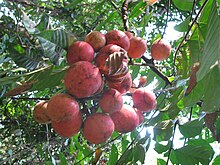
Back Meliaceae Afrikaans أزدرختية Arabic ازدرختيه ARZ Meliaceae AST Meliyakimilər Azerbaijani ملیه کیمیلر AZB Махагонови Bulgarian Meliaceae BS Meliàcies Catalan Meliaceae CEB
| Meliaceae Temporal range:
| |
|---|---|

| |
| Melia azedarach in flower | |
| Scientific classification | |
| Kingdom: | Plantae |
| Clade: | Tracheophytes |
| Clade: | Angiosperms |
| Clade: | Eudicots |
| Clade: | Rosids |
| Order: | Sapindales |
| Family: | Meliaceae Juss.[1] |
| Subfamilies | |
Meliaceae, the mahogany family, is a flowering plant family of mostly trees and shrubs (and a few herbaceous plants, mangroves) in the order Sapindales.
They are characterised by alternate, usually pinnate leaves without stipules, and by syncarpous,[2] apparently bisexual (but actually mostly cryptically unisexual) flowers borne in panicles, cymes, spikes or clusters. Most species are evergreen, but some are deciduous, either in the dry season or in winter.
The family includes about 53 genera and about 600 known species,[3] with a pantropical distribution; one genus (Toona) extends north into temperate China and south into southeast Australia, another (Synoum) into southeast Australia, and another (Melia) nearly as far north. They most commonly grow as understory trees in rainforests, but are also found in mangroves and arid regions.[4]
The fossil record of the family extends back into the Late Cretaceous.[5]

- ^ Angiosperm Phylogeny Group (2009). "An update of the Angiosperm Phylogeny Group classification for the orders and families of flowering plants: APG III". Botanical Journal of the Linnean Society. 161 (2): 105–121. doi:10.1111/j.1095-8339.2009.00996.x. hdl:10654/18083.
- ^ Of a gynoecium, made up of united carpels
- ^ Christenhusz, M. J. M.; Byng, J. W. (2016). "The number of known plants species in the world and its annual increase". Phytotaxa. 261 (3): 201–217. doi:10.11646/phytotaxa.261.3.1. Archived from the original on 2016-07-29. Retrieved 2016-07-14.
- ^ Heywood, V.H.; Brummitt, R.K.; Culham, A.; Seberg, O. (2007). Flowering Plant Families of the World. Ontario, Canada: Firefly Books. p. 207. ISBN 9781842461655.
- ^ Atkinson, Brian A. (January 2020). "Fossil evidence for a Cretaceous rise of the mahogany family". American Journal of Botany. 107 (1): 139–147. doi:10.1002/ajb2.1416. ISSN 0002-9122. PMID 31903551.
© MMXXIII Rich X Search. We shall prevail. All rights reserved. Rich X Search